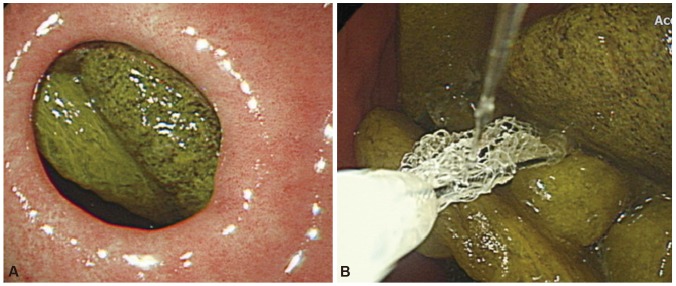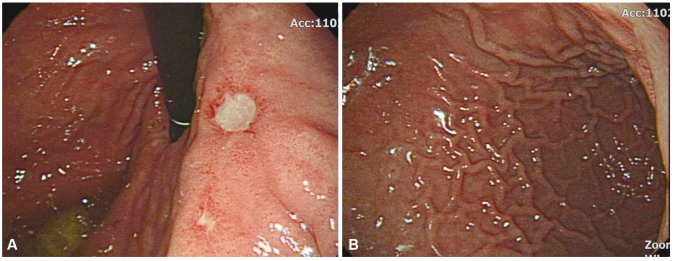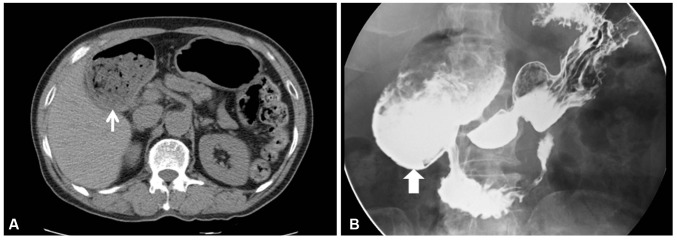Clin Endosc.
2015 Sep;48(5):436-439. 10.5946/ce.2015.48.5.436.
Megaduodenum with Duodenal Diospyrobezoars
- Affiliations
-
- 1Department of Internal Medicine, Kyungpook National University School of Medicine, Daegu, Korea. lhsworld@nate.com
- KMID: 2148557
- DOI: http://doi.org/10.5946/ce.2015.48.5.436
Abstract
- Bezoars are retained masses of ingested materials accumulating within the gastrointestinal track. While gastric bezoars are often observed, duodenal bezoars are rarely reported. A 77-year-old man who had frequently consumed persimmons and had never undergone gastric surgery had symptoms of epigastric pain and early satiety for 10 days. Esophagogastroduodenoscopy showed many diospyrobezoars in a severely distended duodenal bulb, otherwise known as megaduodenum. The patient's treatment consisted of repeated endoscopic removal of the bezoars by using a retrieval net.
Keyword
Figure
Reference
-
1. Yang JE, Ahn JY, Kim GA, et al. A large-sized phytobezoar located on the rare site of the gastrointestinal tract. Clin Endosc. 2013; 46:399–402. PMID: 23964339.
Article2. McKechnie JC. Gastroscopic removal of a phytobezoar. Gastroenterology. 1972; 62:1047–1051. PMID: 5029071.
Article3. de Toledo AP, Rodrigues FH, Rodrigues MR, et al. Diospyrobezoar as a cause of small bowel obstruction. Case Rep Gastroenterol. 2012; 6:596–603. PMID: 23271989.
Article4. Lytras D, Olde-Damink SW, Imber CJ, Hatfield A, Amin Z, Malago M. Duodenal web in an adult presenting with acute pancreatitis and acquired megaduodenum: report of a case. Surg Today. 2011; 41:426–429. PMID: 21365431.
Article5. Karstensen J, Raahave D, Kirkegaard P. Mega-duodenum and constipation after surgery for congenital atresia of the jejunum. Ugeskr Laeger. 2011; 173:1808–1809. PMID: 21689512.6. Barnett WO, Wall L. Megaduodenum resulting from absence of the parasympathetic ganglion cells in Auerbach's plexus; review of the literature and report of a case. Ann Surg. 1955; 141:527–535. PMID: 14362386.7. Zhang XW, Abudoureyimu A, Zhang TC, et al. Tapering duodenoplasty and gastrojejunostomy in the management of idiopathic megaduodenum in children. J Pediatr Surg. 2012; 47:1038–1042. PMID: 22595598.
Article8. Mansell PI, Tattersall RB, Balsitis M, Lowe J, Spiller RC. Megaduodenum due to hollow visceral myopathy successfully managed by duodenoplasty and feeding jejunostomy. Gut. 1991; 32:334–337. PMID: 1901564.
Article9. Boeckxstaens GE, Rumessen JJ, de Wit L, Tytgat GN, Vanderwinden JM. Abnormal distribution of the interstitial cells of cajal in an adult patient with pseudo-obstruction and megaduodenum. Am J Gastroenterol. 2002; 97:2120–2126. PMID: 12190188.
Article10. Kudoh K, Shibata C, Funayama Y, et al. Gastrojejunostomy and duodenojejunostomy for megaduodenum in systemic sclerosis sine scleroderma: report of a case. Dig Dis Sci. 2007; 52:2257–2260. PMID: 17420947.
Article11. Singh SK, Marupaka SK. Duodenal date seed bezoar: a very unusual cause of partial gastric outlet obstruction. Australas Radiol. 2007; 51(Spec No.):B126–B129. PMID: 17875133.
Article12. Lee BJ, Park JJ, Chun HJ, et al. How good is cola for dissolution of gastric phytobezoars? World J Gastroenterol. 2009; 15:2265–2269. PMID: 19437568.
Article
- Full Text Links
- Actions
-
Cited
- CITED
-
- Close
- Share
- Similar articles
-
- A Case of Resolution of Duodenal Obstruction Caused by Duodenal Ulcer after the Eradication of Helicobacter pylori Infection
- Three Cases of Coexistence of Gastric Cancer and Duodenal Ulcer
- Annular Pancreas with a Duodenal Web: a Rare Presentation with Simultaneous Intrinsic and Extrinsic Duodenal Obstruction
- Duodenal Injury after Blunt Abdominal Trauma: Report of Two Cases
- A Case of Coexistence of Gastric Cancer and Duodenal Ulcer




